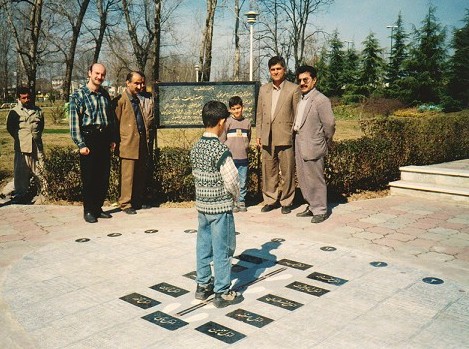
Analemmatic dials
Rasht (Gilan province, Iran)

The first analemmatic sundial of Iran has been constructed in Mellat Park (People's Park) in Rasht, under the auspices of Thaqib Astronomical Society of Gilan.
The major axis of the sundial is 4.0 meter (13 ft). A nice size for kids, as one can see in the picture above. A bit too small for adults, as is demonstrated by the guy below. The shadow of his body on the hour ring is over an hour wide, which hampers accurate reading.
The building in the background houses Thaqib Astronomical Society of Gilan Province.
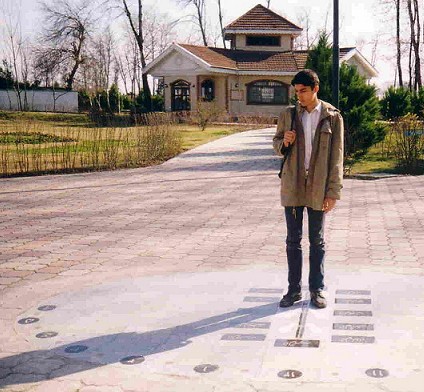
Hour numbers run from 6 to 6 (18) hr local time, with small half-hour points in between. The date line is provided with the Iranian months (see the section on the Iranian calendar below). The Iranian year starts at the spring equinox. Thus, an aesthetic, symmetric date scale arises, as is the case with zodiacal months. Five pairs of foot prints in white tell the visitors to stand right over the date line and not on the name of the month. Very nice!
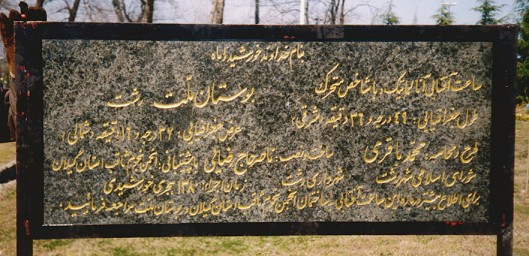
The information panel reads:
In the name of the God of the sun and the moon
Analemmatic sundial with moving gnomon, Mellat Park, Rasht
Geogr. long. 49°36' E, geogr. lat. 37°16' N
Design and calculation by Mohammad Bagheri
Construction and mounting by Nasser Haj Reza'i
Sponsors: Thaqib Astronomical Society of Gilan province, Islamic Council of Rasht, Municipality of Rasht
Date of construction: 1380 Anno Hejira Solar
For more information on this sundial please refer to the headquarters of Thaqib Astronomical Society of Gilan Province in Mellat Park
At the occasion of the second anniversary of Thaqib Astronomical Society in June 2002, a small bronze panel containing the EoT diagram and the method for finding clock time was mounted beside the main panel.
Construction started in September 2001 and was sponsored by the Municipality and the City Council of Rasht. The inauguration took place in March 2002. Click the thumbnails for pictures.
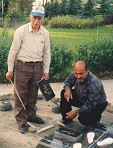 |
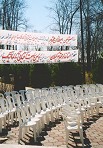 |
In September 2002, a Sundial Group was formally established as a working branch of Thaqib Astronomical Society. The members, mostly young schoolgirls, plan to study the history, mathematics, as well as the astronomical and artistic aspects of sundials. They plan to construct several sundials in the park, as well as design sundials for cultural buildings across the province of Gilan.
For information, exchange of ideas and cooperation please contact Mohammad Bagheri.
Rasht is the capital of the green province of Gilan, some 240 km (150 miles) north-west of Tehran. It is located favorably in between the Caspian Sea in the north, where one can swim most of the year, and the Elburz mountain range in the south, where one can ski most of the year.
The Iranian calendar
The date "1380 Anno Hejira Solar" refers to the Iranian calendar. Hejira is the lunar Islamic calendar. It started in 622 AD with the flight of Mohammad from Mecca to Medina. The Islamic year consists of 12 lunar months, some 355 days. The Islamic year therefore shifts slowly through the solar year. January 1, 2000 A.D. (Anno Domini) was ca. 24 Ramadan (9th month) 1420 A.H. (Anno Hegirae) ('ca.' because of some uncertainty in determining when the New Moon is first visible). The present Hejira date can be obtained from this site.
The Iranian year, on the contrary, is a solar year, which starts at the spring equinox (March 20 or 21). It has 12 months, six of 31 days, followed by five months of 30 days and one of 29 days. Once every 4 years (occasionally 5) the latter gets an extra leap day. As a result, the approximation of the solar year is even better than in the Gregorian calendar. See this link for details. The Iranian calendar also started in 622 AD, therefore it is denoted as Hejira Solar. January 1, 2000 was 11 Dey (10th month) 1378 A.H.S. The present Hejira Solar date can be obtained from this site.
The Iranian months are laid out around the date line in counterclockwise order, as follows (compare to the top picture on this page). The tiles indicate the first day of the month.
North
| 4. Tir | ||
| 5. Mordad | \ / | 3. Khordad |
| 6. Shahrivar | \ / | 2. Ordibehesht |
| 7. Mehr | \ / | 1. Farvardin |
| 8. Aban | \ / | 12. Esfand |
| 9. Azar | \ / | 11. Bahman |
| 10. Dey | ||
Note. The transcription of Iranian and Arabic names may vary somewhat according to the source and the language.
I thank Mohammad Bagheri for the pictures and the additional information. Parisa translated some Iranian texts. Reinhold Kriegler stimulated me to make these pages. I have also used the following articles:
- Mohammad Bagheri, The first analemmatic sundial in Iran, NASS Compendium Vol.9 nr.4, December 2002, p. 24,
- Reinhold Kriegler, Rasht, Keimzelle einer neuen iranischen Sonnenuhren-Blüte? DGC Mitteilungen Nr. 93, Frühjahr 2003, p.5-7. Read this issue on-line (in PDF format).
I dedicate these pages to the group of people who, despite severe political uncertainties including war and threat of war in neighboring countries, have the courage and sense of responsibility to put so much effort into the study and dissemination of these universal cultural treasures of mankind.
Location: 37.3° N, 49.6° E
Design: Mohammad Bagheri
Construction: Nasser Haj Reza'i
Inauguration: March 2002